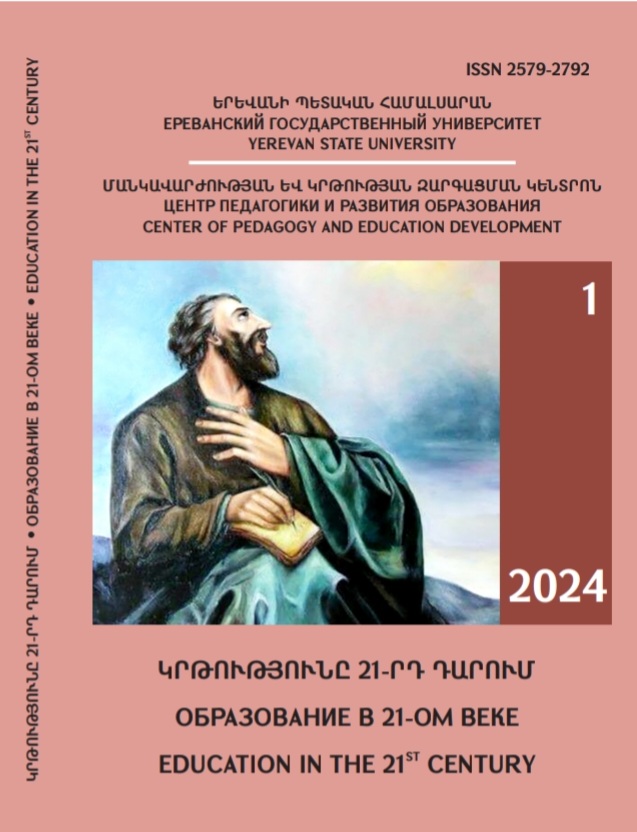FEATURES OF TEACHING THE CHARACTERISTICS OF THE MODERN NANOSTRUCTURED GAS SENSORS IN UNIVERSITIES
DOI:
https://doi.org/10.46991/ai.2024.1.56Keywords:
nanostructured gas sensors, high-tech teaching, teaching characteristics in universities, obtaining experimental knowledge, studentsAbstract
The article is devoted to the peculiarities of the teaching nanostructured gas sensors in universities and the problems existing here. The professional literature on this topic was studied, the necessity of using gas sensors in various systems was presented, and the need for courses on gas sensors in the modern universities was justified. The main subsections of the course, the most important provisions included in them, and their teaching methods are presented. Teaching a course on nanostructured gas sensors in universities requires the use of modern methods, including both the experimental and the theoretical knowledge. It is necessary to teach the subject using experimental works with modern measuring and technological equipment. For the good assimilation and the easy knowledge transfer of courses on the nanostructured gas sensors, students need prior knowledge of semiconductor physics, materials science, chemistry, and other related fields.
References
Ալեքսանյան Մ., Կիսահաղղորդչային գազային սենսորների առանձնահատկությունները (ուսումնամեթոդական ձեռնարկ), ԵՊՀ հրատարակչություն, Երևան, 52 էջ, (2020)։
Aleksanyan M. et al., Room Temperature Detection of Hydrogen Peroxide Vapor by Fe2O3:ZnO Nanograins, Nanomaterials, Vol. 13, 2022, p.120.
Aleksanyan M. et al., Detection of hydrogen peroxide vapor using flexible gas sensor based on SnO2 nanoparticles decorated with multi-walled carbon nanotubes. Advances in Natural Sciences: Nanoscience and Nanotechnology, Vol. 14, 2023, p. 025001.
Capone S. et al., Solid state gas sensors: state of the art and future activities, Journal of Optoelectronics and Advanced Materials, Vol. 5, 2003, pp. 1335-1348.
Fusnik L. et al., A Review of Gas Measurement Set-Ups, Sensors, Vol. 22, 2022, p. 2557.
Gupta A. and Verma G., Book of Nanostructured Gas Sensors (Fundamentals, Devices, and Applications), New York, Jenny Stanford Publishing, 2023, 184 pp.
Korotchenkov G., Metal oxides for solid-state gas sensors: What determines our choice?, Materials Science and Engineering: B, Vol. 139, 2007, pp. 1-23.
Krishna K. et al., Nanostructured metal oxide semiconductor-based gas sensors: A comprehensive review, Sensors and Actuators A: Physical, Vol. 341, 2022, p. 113578.
Leask R. et al., The impact of practical experience on theoretical knowledge at different cognitive levels, J S Afr Vet Assoc., Vol. 91, 2020, p. 2042.
Sparkman D. et al., Gas Chromatography and Mass Spectrometry: A Practical Guide, Academic Press, Elsevier Inc., (978-0-12-373628-4), 2011, pp. 589-611.
Wetchakun K. et al., Semiconducting metal oxides as sensors for environmentally hazardous gases, Sensors and Actuators B: Chemical, Vol. 160, 2011, pp. 580-591.
Wilson R. et. al., Innovative Teaching of IC Design and Manufacture Using the Superchip Platform, IEEE Transactions on Education IEEE, Vol. 53, 2010, pp. 297-305.
Yun J. et al., A review of nanostructure-based gas sensors in a power consumption perspective, Sensors and Actuators B: Chemical, Vol. 372, p. 132612.
Zhong Y. et al., Intelligent Manufacturing in the Context of Industry 4.0: A Review, Engineering,
Vol. 3, 2017, pp. 616-630
Downloads
Published
How to Cite
Issue
Section
License
Copyright (c) 2024 Mikayel Aleksanyan

This work is licensed under a Creative Commons Attribution-NonCommercial 4.0 International License.

